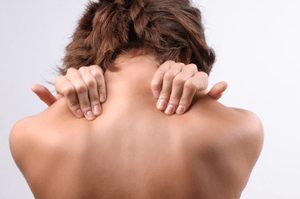With more than 15 million people in the Los Angeles area, clogged freeways and the need to rush all over town it's little wonder that so many folks are stressed-out. Some of the more unfortunate experience one or more auto accidents. This often is confirmed as whiplash.
In the case of whiplash, at the moment of impact enormous forces are exerted into the soft tissues of both the anterior and posterior neck. This may approach several hundreds or even thousands of pounds per cubic inch within a fraction of a second. The force of the initial impact hyperextends muscles in the back and front of the neck. Further damage is caused by the whipping action of the head a split second later as the head rocks forward and the resulting sprain and inflammation.
Remember, whiplash, like it's namesake is comprised of two separate motions. The first motion, the 'whipping' motion forces the skull to rock backwards damaging the S.C.M. muscles that attach to the front of the neck. Then the 'lash' motion throws the head and body forward straining the muscles within the back of the neck.
This action can then create spasm in the large diamond shaped trapezius muscle. This muscle attaches at its base to the 10th thoracic vertebrae of the spine. The nerve from the stomach exits the spinal column here. The pressure exerted on nerves here can be enough to cause vomiting. Following a violent whiplash chronic headaches may result.
For those who suffer crippling headaches from time to time and can’t seen to get relief fast enough, neuromuscular therapy and deep tissue massage therapy may be the non-drug, non-surgical alternative for pain relief. While some headaches, such as valsalva, can be triggered by coughing or sneezing others forms of headache such as migrane can be caused by chemical imbalances within the cerebral vasculature. Still there are other chronic headaches and even TMJ condition that are muscular in nature due to cranial bone misalignments. Neuromuscular therapy and deep tissue massage therapy can addresses these chronic muscular issues. By relaxing and releasing fixated muscle tissue through out the neck, head, and face the chronic pain can be radically reduced and even eliminated.
When a trauma occurs, damaged tissues send a strong sensory pain signal to the brain. The brain in turn responds by returning a motor signal amplified x10 to the muscles in the area to immobilize or 'splint' the affected tissues. The body does this by inflaming the area and getting tight. As the distress signal continues reaching the brain, it response with a motor response. Using Neurotransmitter chemicals instruct other surrounding muscles to 'recruit' and assist in stabilizing the compromised tissues. While the pain of the injury is in one’s conscious awareness, and even after pain ceases, that particular neuro pathway is being traversed many more times than other neuro-pathways in the area. During this process the myelin sheath covering grows thicker, resulting in lower resistance to subsequent nerve impulses. This is known in neurology as the “Law of Facilitation.” This results in a physical thickening of the nerves structure with less resistance. Therefore, future injuries, even in other parts of the body, can reactivate this old neuropathway.
Back pain seems to be a common feature of the health and fitness landscape. One reason for the persistence of low back pain is structural instability. The three bones that comprise the pelvis (R. ilium, L. ilium and the sacrum). These may have a skewed relationship to one another. One hip can be pitched forward and the other backward, creating a sheering that occurs at the S.I. joint. This can show up as anything from chronic low-grade hip pain or 'lumbago' to crippling sciatic pain.
Experience in almost all cases have directed me to work the rectus femurs muscles. Located on the anterior side of the legs and not where the pain occurs within the back itself. Although the rectus femoris is a part of the quadricep group, which when tight can anteriorly pitch ether one of the ilium bones forward. This is a major issue with runners, those who weight train, practice Pilates, or perforce and pole dancing, and anyone who wears high heels. These factors change the geometry of how the pelvic bones are position relative to one another.
Another major muscle that can profoundly contribute to crippling back and hip pain is the psoas major. The psoas major, located bi-laterally in the back of the abdominal cavity, can then be over-taxed to the point of spasm. Due to the proximity of this muscle to the sciatic nerve, it is easy to understand how a misstep one day, result in pain the next.
Neck pain is no fun either. If you are using the computer, driving or holding a posture with your head in a forward-fixated position, your muscle tissue can get into trouble. When its oxygen requirements exceed available resources through demand, the cells must go into oxygen debt. This happens ether by excessive concentric or eccentric muscular contraction. (Concentric muscular contraction moves a bone or a limb. Picking up an object. Eccentric muscular contraction is where the muscles act as stabilizing cords holding a limb stationary in space and against gravity. Craning one’s head forward to view a computer screen.
For example: If we sit with a forward head posture we can be off as much as five degrees. For each half a degree, the weight of the head relative to the supporting muscles is doubled. 10 lbs. x 5 degrees. It’s easy to see how that can lead to spasm in the neck muscles and nerve entrapment of the greater and lesser occipital nerves. Neuromuscular therapy and deep tissue massage therapy can greatly reduce if not out-right eliminate the achy painful effects of this in some times as little as three sessions. Direct application of soothing neuromuscular therapy or deep tissue massage therapy work to release the sub-occipital muscles. Time and time again this yields excellent pain reducing results.


